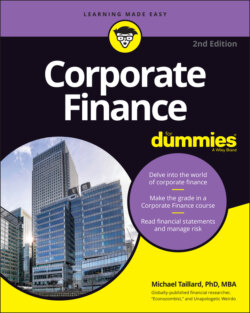Читать книгу Corporate Finance For Dummies - Michael Taillard - Страница 3
Corporate Finance For Dummies® To view this book's Cheat Sheet, simply go to www.dummies.com and search for “Corporate Finance For Dummies Cheat Sheet” in the Search box. Table of Contents
Оглавление1 Cover
2 Title Page
3 Copyright
4 Introduction About This Book Foolish Assumptions Icons Used in This Book New to this Edition Beyond the Book Where to Go from Here
5 Part 1: What’s Unique about Corporate Finance Chapter 1: The Tale of Corporate Finance Telling a Story with Numbers Characterizing Motivations Setting the Stage Chapter 2: Introducing Finance Land Visiting the Main Attractions in Finance Land Getting a Job in Finance Land Visiting the Finance Land Information Center Chapter 3: Pitching Your Story for Money Raising Capital Diving into Debt Schmoozing Investors Having Your Wish Granted
6 Part 2: Making a Statement Chapter 4: Staying Balanced Introducing the Balance Sheet Evaluating the Weights on the Balance Scale Understanding Assets Learning about Liabilities Eyeing Owners’ Equity Finding Financial Zen Chapter 5: Incoming Income Adding It Up Putting the Income Statement to Good Use Chapter 6: Going with the (Cash) Flow Moving Along Three Smooth Flows Reaching Your Destination Chapter 7: Mastering Metrics Paying the Bills Working Your Assets Chapter 8: Calculating Capital Sizing Up Shareholders Banking on Metrics Keeping Debt Healthy
7 Part 3: Valuations on the Price Tags of Business Chapter 9: Determining Present and Future Values: Time Is Money Losing Value over Time Predicting Future Value Calculating the Present Value Chapter 10: Calling in the Cavalry Budgeting Capital Rating Your Returns Netting Present Values Paying It Back Allocating Capital Managing Projects Chapter 11: Bonding Over Business Exploring the Different Types of Bonds Reviewing Bond Rates Reading Bond Information Understanding Bond Valuation Chapter 12: Savvy Stock Sales Exchanging Stocks Looking at the Different Types of Orders Comparing Long and Short Stocks Defining Caps and Sectors Raging Bulls and Grizzly Bears Beating Stock Indices? Imagining the Value of Stocks Chapter 13: Pricing Probability from Derived Value Deriving Value Keeping Your Options Open Paying It Forward Standardizing the Future Swapping Numbers
8 Part 4: A Wonderland of Risk Management Chapter 14: Managing Uncertainty Understanding that Risk Is Unavoidable Risking Your Interest with Inflation Minimizing Market Risk Giving Credit Where It’s Due Getting Shady with Off-Balance-Sheet Risk Factoring in Foreign Exchange Risk Identifying Operating Risk Looking at Liquidity Risk Sorting Your Customer’s Laundry Chapter 15: Through the Looking Glass of Modern Portfolio Theory Delving into Portfolio Basics Joking about Market Efficiency Risking Returns Optimizing Portfolio Risk Chapter 16: Financially Engineering Yourself Deeper Down the Rabbit Hole Making Securities Out of Anything Splicing Hybrids Bundling Assets Exploring Exotics Engineering Finances Moving into Computational Finance Chapter 17: Weighing Capital Calculating the Cost of Capital Choosing the Proper Capital Structure
9 Part 5: Financial Management Chapter 18: Assessing Financial Performance Analyzing Financial Success Using Common-Size Comparisons Performing Comparatives Determining the Quality of Earnings Assessing Investment Performance Chapter 19: Forecasting Finances Seeing with Analytical Eyes Viewing the Past as New Seeing the Future Unclouded: Forecasting Chapter 20: Getting the Deets on M&A Dissecting M&A Moving Beyond the M and the A Divesting Is Investing Measuring What a Business Is Worth to You Financing M&A
10 Part 6: The Part of Tens Chapter 21: Ten Things You Need to Know about International Finance There’s No Such Thing as a Trade Imbalance Purchasing Power and Exchange Rates Are Different Things Interest Rates and Exchange Rates Have a Muddled Relationship Spot Rate Isn’t the Only Type of Currency Transaction Diversification Can’t Completely Eliminate Risk Exposure Cross-Listing Allows Companies to Tap the World’s Resources Outsourcing Is a Taxing Issue Politics Complicate Your Life Cultural Understanding Is Vital Cryptocurrencies Come with Risk Chapter 22: Ten Things You Need to Understand about Behavioral Finance Making Financial Decisions Is Never Rational Being Irrational Can Be Entirely Rational Framing Affects Your Decision-Making Prowess Making Sound Financial Decisions Involves Identifying Logical Fallacies Getting Emotional about Financial Decisions Can Leave You Crying Financial Stampeding Can Get You Trampled Letting Relationships Influence Finances Can Be Ruinous Satisficing Is Good Enough Prospect Theory Explains the Improbable Being Biased Is Human Nature
11 Index
12 About the Author
13 Advertisement Page
14 Connect with Dummies
15 End User License Agreement
